Today, the F/A-18 Hornet and Super Hornet form the backbone of American naval aviation, as well as serving in the air forces of seven other nations. Even though the F-35 is beginning to replace it in service, it will remain important for decades to come.
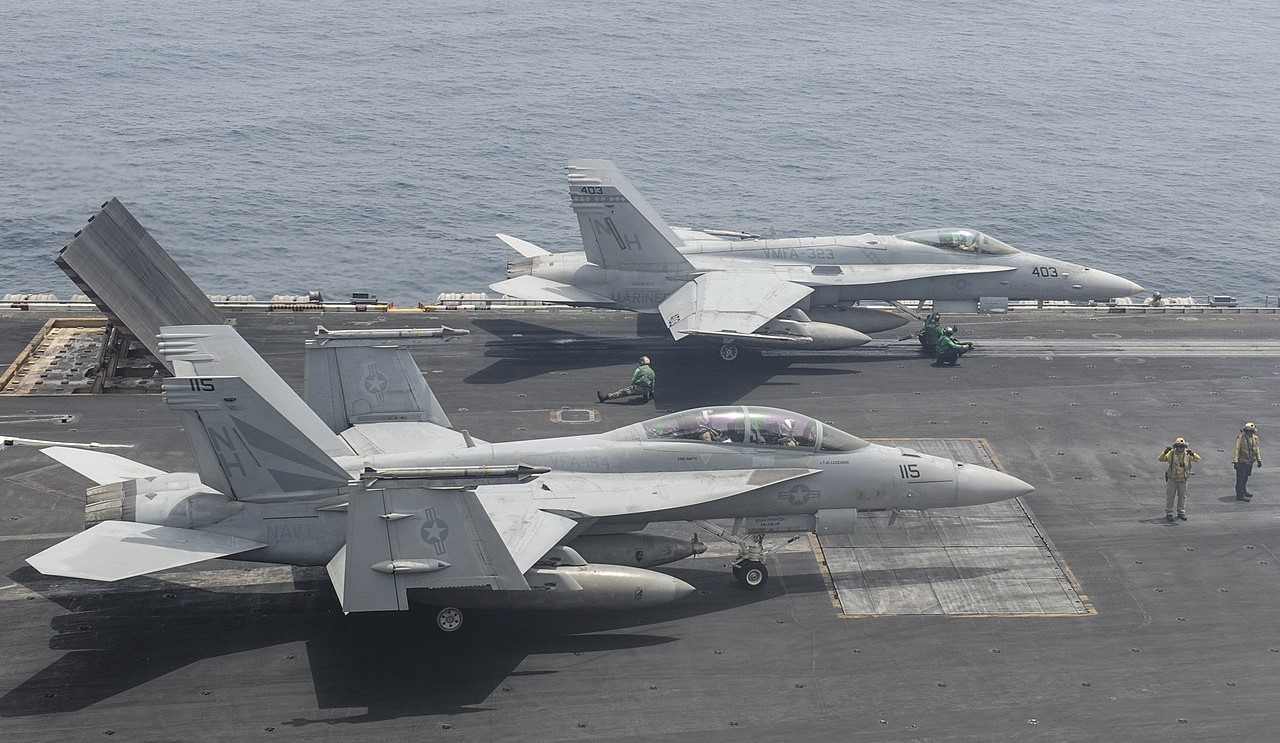
An F/A-18F Super Hornet (front) and an F/A-18C Hornet on the deck of a carrier
The F/A-18 story began not with the Navy, but with the Air Force. One lesson that many took from the Vietnam War was the continued importance of dogfighting, and pressure began to build for a light day fighter to fill that role in a future war, resulting in the Lightweight Fighter program in the early 70s. General Dynamics and Northrop were chosen to build prototypes for a competitive flyoff, producing the YF-16 and YF-17 respectively. The YF-16 was eventually selected, thanks to slightly superior performance and its use of a single engine, which provided commonality with the new F-15. As it developed, it gained more multirole capability, eventually emerging as the very successful F-16 Fighting Falcon.
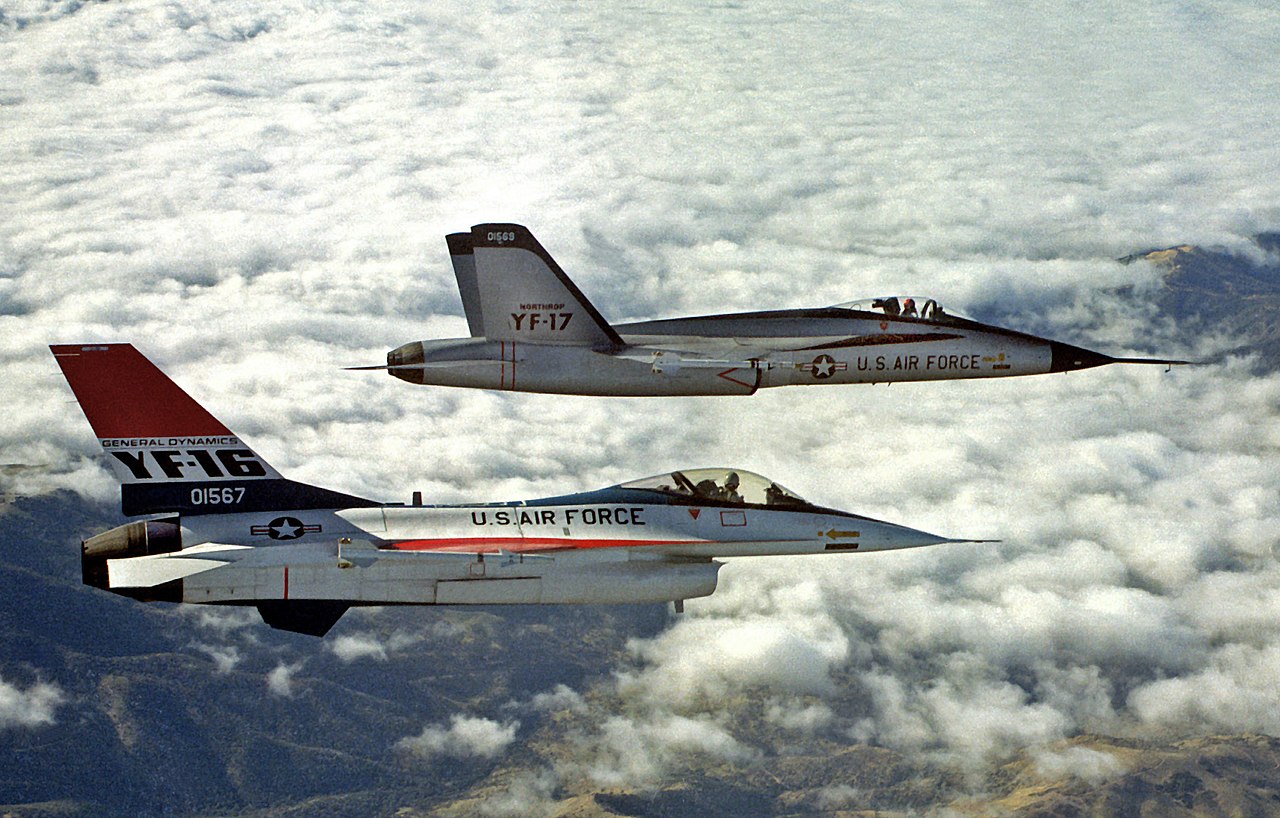
YF-16 and YF-17 fly together
While all of this was going on, it was becoming increasingly clear that the Navy would need a new aircraft of the same general type fairly soon. The F-14, while a very capable aircraft, was also big and expensive, and it had no air-to-ground capability. A smaller, cheaper multirole plane was needed to replace the remaining F-4s, A-4s and A-7s, and Congress directed that one of the Lightweight Fighter prototypes should form the basis for it. Neither GD nor Northrop had any experience with carrier aircraft, so they teamed up with companies that did, LTV Vought and McDonnell Douglas respectively. Both would take a great deal of work to meet the Navy's requirements, and the ultimate decision was to go with a design loosely based on the twin-engine YF-17 over a derivative of the single-engine F-16. The engine configuration was regularly cited as the main reason, the Navy desiring redundancy for overwater operations, but this strikes me as at least somewhat dubious. Two of the three planes the new aircraft would replace had one engine, and modern jets are very reliable. An alternative explanation is that the F-16 was going to be more difficult to navalize, thanks largely to its landing gear setup, and McDonnell Douglas was more willing to build a new plane that looked like the YF-17 for the Navy.
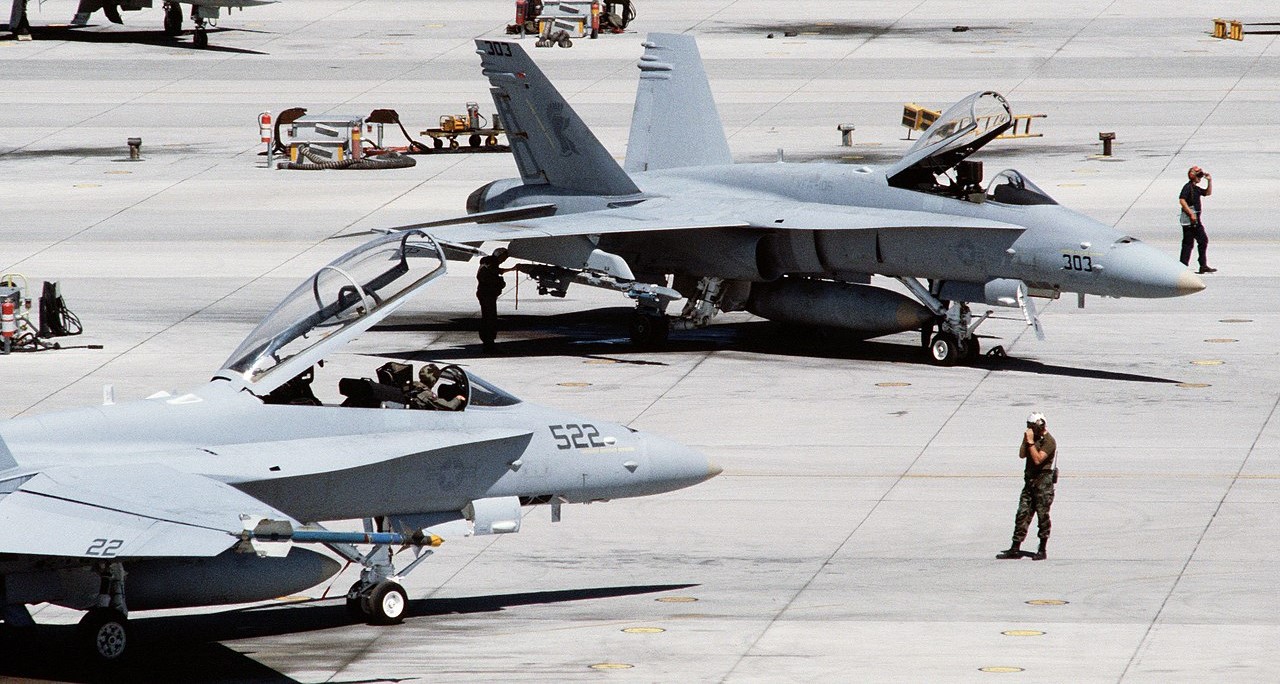
An F/A-18A and B on an exercise
Astonishingly, they were even willing to admit that this was what they were doing, and the new design (which had a gross weight of 33,000 lb vs 23,000 lb for the YF-17) was given a new designation, the F-18 Hornet.1 Originally, the plan was to procure three different variants of the airplane. The bulk of the fleet would be split between the F-18, with electronics for air combat, and the A-18, specialized in ground attack, while the TF-18 would have two seats for pilot training. However, advances in avionics in the late 70s meant that it was possible to fit a single airplane with the systems for both roles, and starting in 1980, the two single-seat variants were consolidated into the F/A-18A, while the TF-18 was redesignated the F/A-18B and given full combat capability. There were also plans for Northrop, which remained part of the program, to build a variant, the F-18L, for export to other countries. Reduction in fuel load and removal of various naval systems would allow weight to fall by about 25%, with the added bonus that it could sustain 9G maneuvers instead of the 7.5G of the naval version. Unfortunately, despite interest from several nations, Northrop found no buyers, at least in part due to competition from McDonnell Douglas, which put the naval Hornet on the international market.
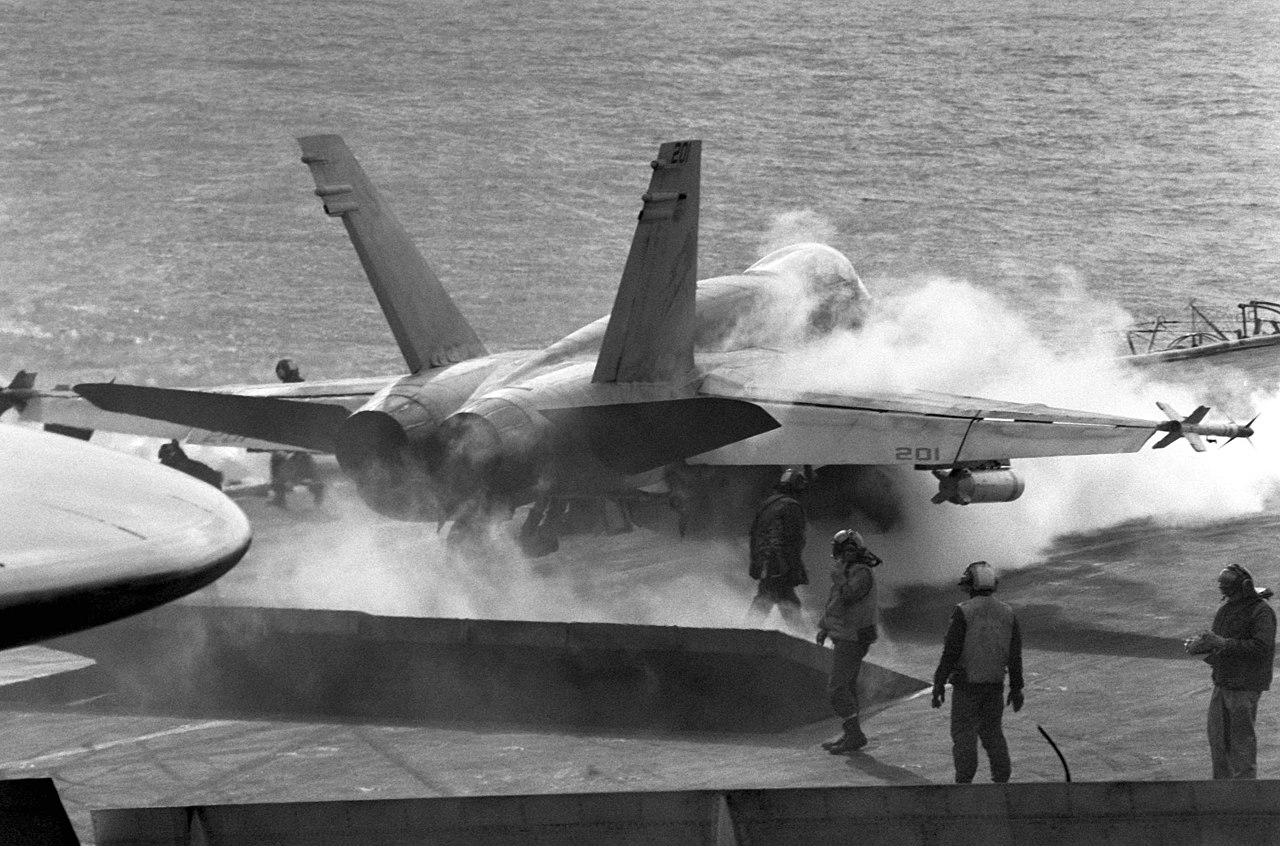
A Hornet is readied for launch aboard Coral Sea during its first carrier deployment
The first F/A-18A rolled out of the McDonnell Douglas factory in St. Louis, Missouri in September 1978, and flew two months later. The flight test program went reasonably well, with the biggest issues discovered being inadequate landing gear, insufficient ailerons, and fatigue cracks in the vertical stabilizer mounts,2 all of which were eventually fixed. The first production Hornets arrived at the training squadron in September 1981, and the first operational squadron, VMFA-314, stood up in January 1983, with the first Navy squadron, V(F)A-113, getting the jet two months later. These early squadrons, which began carrier deployments in 1985, confirmed that the Navy and Marines had a winner on their hands. Particular praise was given to its reliability, which was vastly better than the previous generation of aircraft.
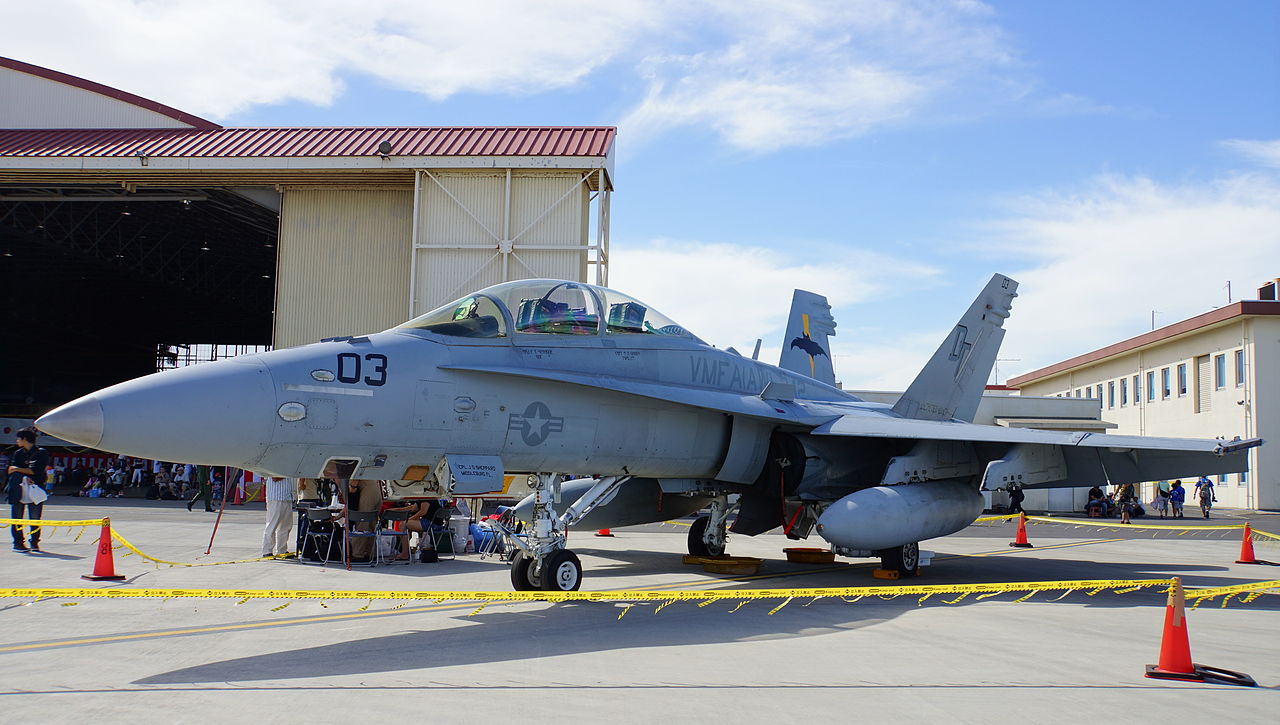
A Marine Night Attack F/A-18D
Even as the F/A-18A was entering service with more squadrons, work was underway on an improved model, the F/A-18C. While externally identical to the earlier jet, the C model Hornet had more powerful engines and a new computer/weapons system that made it far more flexible and easier to upgrade. This brought some limited degree of sensor fusion between the different onboard sensors, as well as the capability to use a number of new weapons, including the AIM-120 AMRAAM and the AGM-65 Maverick, as well as making it much easier to incorporate new weapons going forward. The F/A-18C, and the two-seat F/A-18D, entered production in 1987, and more upgrades soon followed. First was the Night Attack mod, which fitted the cockpit instrumentation for use with night-vision goggles, color multi-function displays and the ability to fit a new FLIR3 pod. The Marines ordered a number of their aircraft as F/A-18Ds to replace their A-6 for the all-weather strike mission, with the flight controls in the rear cockpit replaced by controllers for the weapons.4 Some of these aircraft were further modified to provide the Marine Corps with a continued manned reconnaissance capability, replacing the M61 Vulcan gatling gun with a set of recon instruments known as ATARS. Another upgrade came in the early 90s, when the original APG-65 radar was upgraded to the APG-73, gaining better range and ground-mapping capabilities.
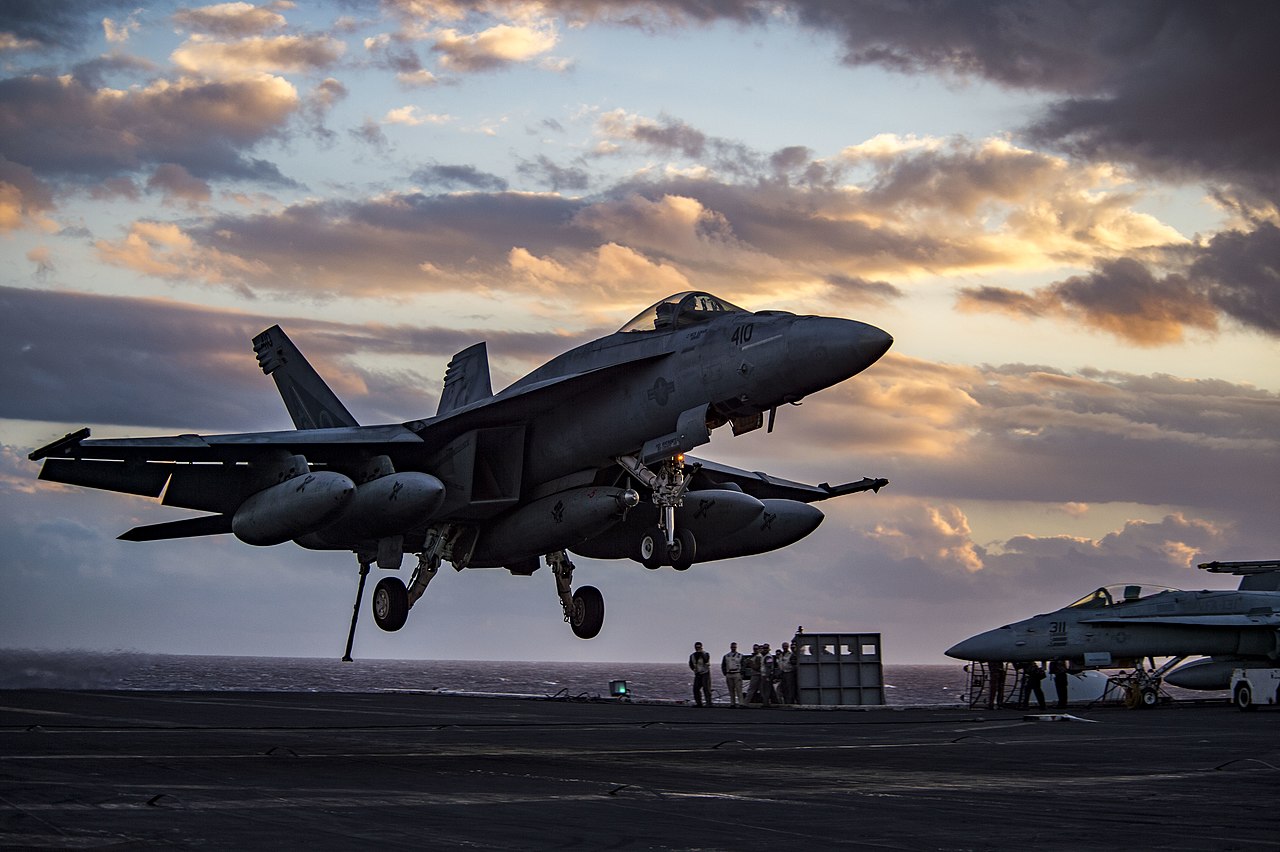
An F/A-18E comes in for a dusk landing
In the late 80s, McDonnell Douglas had its eye on the possible next generation of the Hornet design, notwithstanding the recent entry into service of the F/A-18C/D. The biggest complaints about the Hornet had always been that it was rather short-legged, at least by naval standards,5 and that it was sharply limited on bringback weight.6 they proposed to fix this by building what was essentially an entirely new aircraft that looked quite similar to the existing one. They would get their chance in the aftermath of the Cold War, when Naval Aviation, having lost both the A-12 Avenger II stealth attack aircraft and any chance of building a navalized derivative of the F-22, decided to buy this new design, which would be known as the F/A-18E/F Super Hornet.
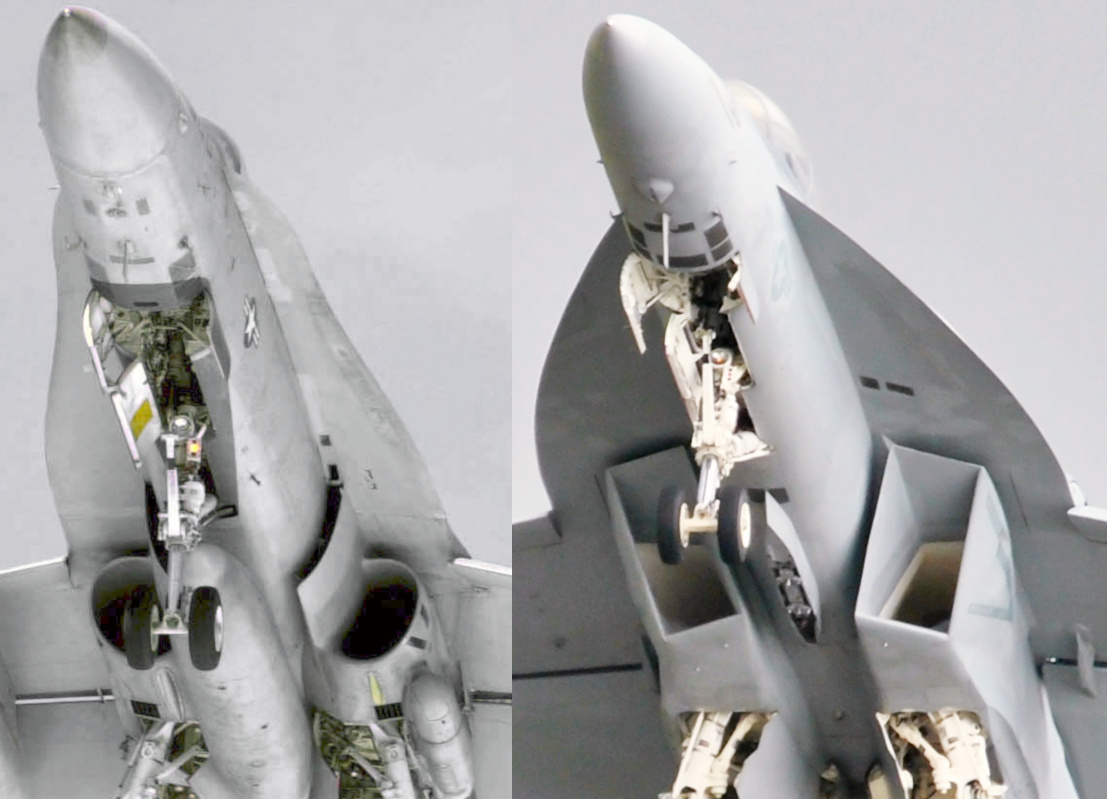
The Hornet and Super Hornet clearly show their different intakes and Leading Edge Extensions
In practice, the Super Hornet name was a clever bit of designation engineering, with the new airframe sharing only about 30% of its structural parts with its predecessor, although avionics commonality was more like 90%. It had a gross weight of 47,000 lb, 10,000 lb more than the Legacy Hornet, and was about 10% larger in physical dimensions. The bigger plane meant more room for fuel, with strike range rising 20-30%, and a bigger wing meant two extra pylons, a lower approach speed and at least three times the bringback weight. Other changes included more powerful engines, which kept performance essentially the same, and careful attention to reduced radar cross-section, which was less than that of the C/D Hornet despite the larger size of the new jet. The RCS reduction effort prompted the most notable visual difference between the two types, as the round inlets on the Legacy Hornet were replaced by square inlets on the Super Hornet.
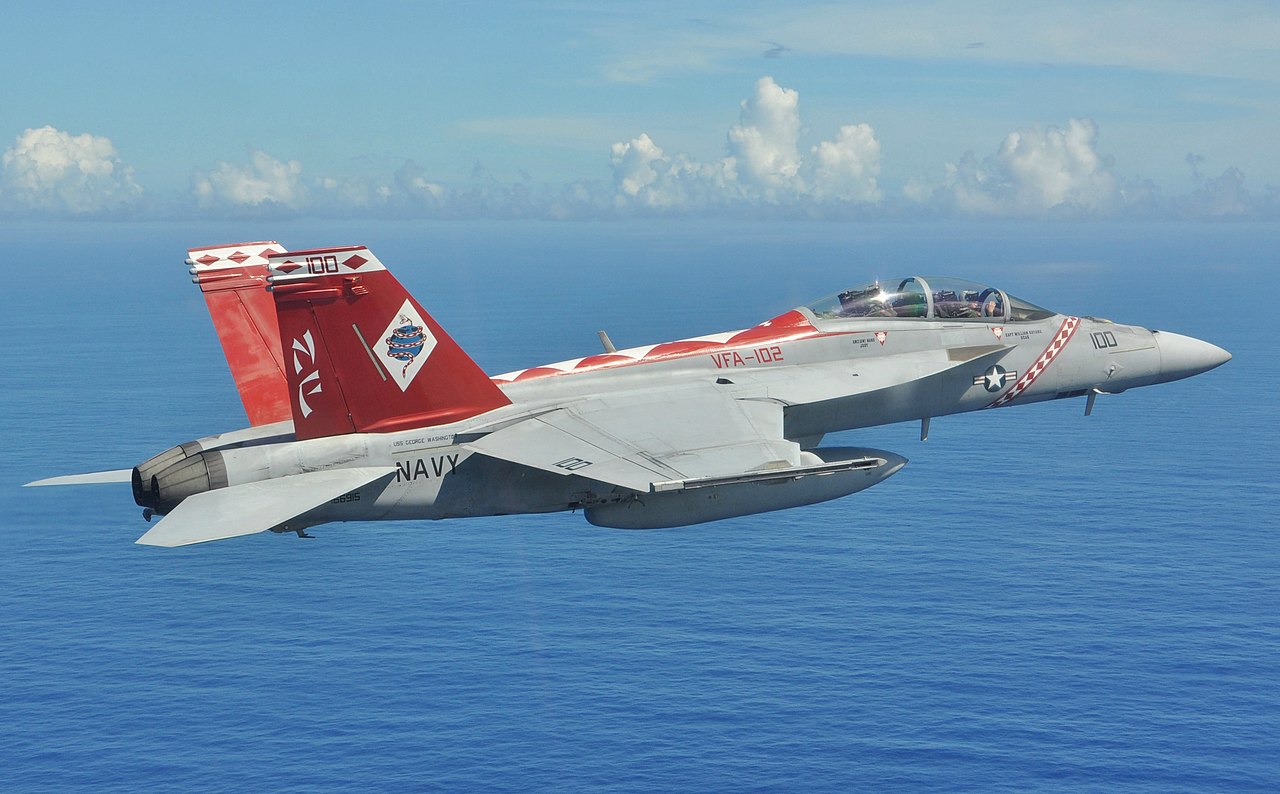
An F/A-18F in flight
The Super Hornet program ran extraordinarily well, completing underweight, under budget and on schedule. The development contract was signed in December 1992, with the first prototype flying just under 3 years later. The first operational squadron transitioned to the new jet in late 2000, and it entered combat over Iraq a year and a half later. Initially, squadrons transitioned to the Super Hornet from the F-14, which was finally retired in 2006, but the Navy then began to convert the existing Legacy Hornet squadrons over as well. The Marines, unwilling to see their F-35 purchase diluted, refused to participate in the Super Hornet program, but the Navy took a leaf out of their book, equipping 10 of their 24 strike fighter squadrons with the F/A-18F.
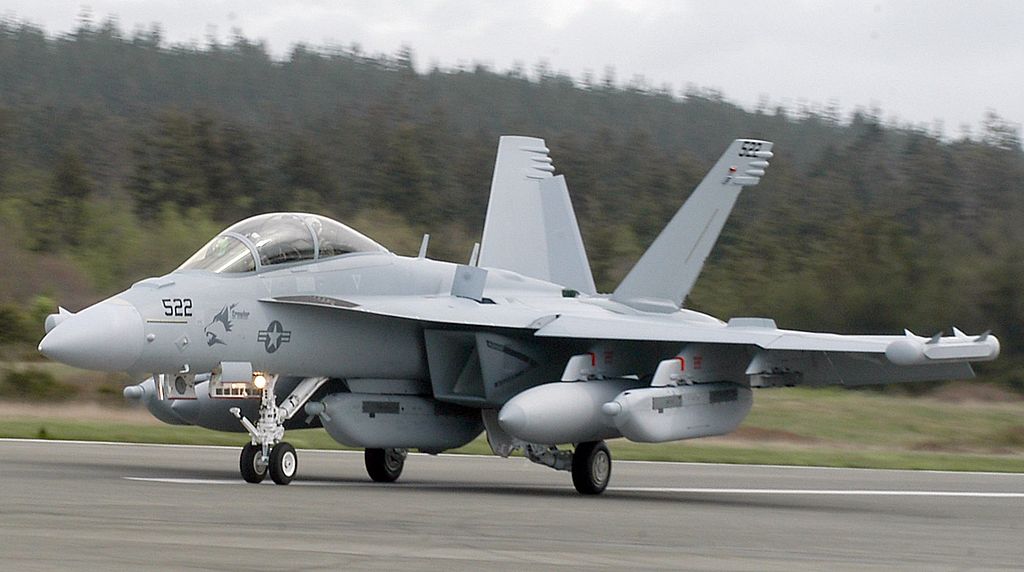
An EA-18G taxiing
The F/A-18F also served as the basis for the last member of the Hornet family to date, the EA-18G Growler. The Growler fills the electronic warfare role not only for the Navy but also for the Air Force, which has four Navy squadrons assigned to support it. It is capable of a wide range of electronic warfare missions, both detecting enemy emitters and jamming them. Electronic surveillance is provided by onboard sensors in the wingtips and in the space previously occupied by the cannon, while jamming is done by ALQ-99 underwing pods, which were previously carried by the EA-6B Prowler. The Growler is still combat-capable, and routinely carries AGM-88 HARMs to kill enemy radars. The only real drawback relative to the Prowler is that the Growler has only a single operator for the electronic warfare systems, as opposed to three on the Prowler. The AESA-based Next-Generation Jammer, which is currently being tested, will hopefully alleviate some of the workload.
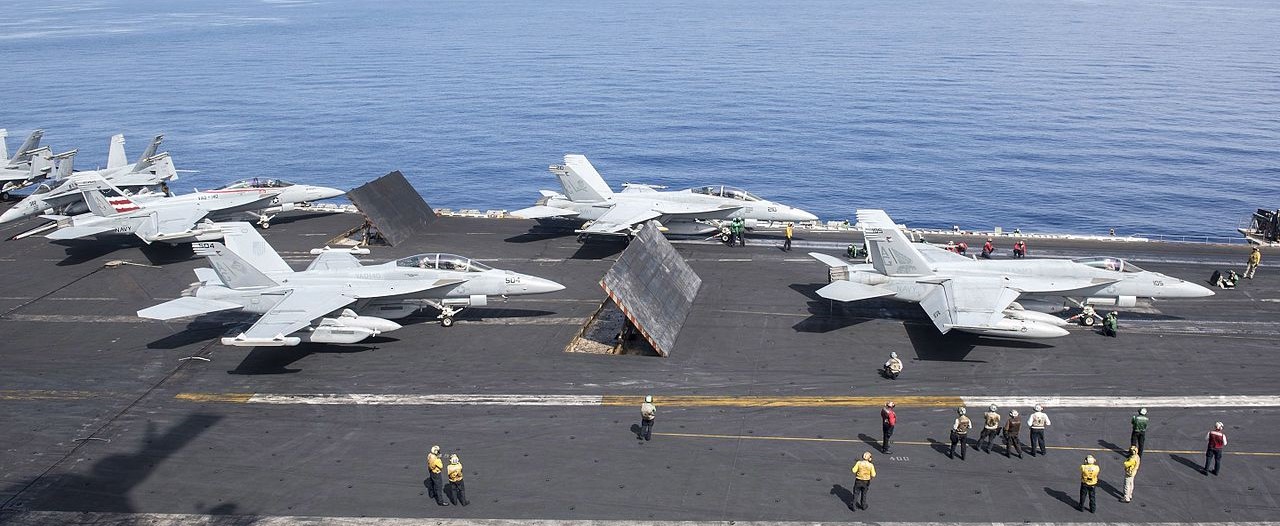
An array of different Hornet models on the flight deck
The Super Hornet has been the subject of a number of upgrades during its service life. The biggest came in 2005, with the Block II configuration, which replaced the APG-73 radar with the APG-79 AESA. Currently, work is underway on the Block III "Advanced Hornet", which will bring a number of upgrades, most notably further RCS reductions, a stealthy external weapons pod, and the capability to carry a pair of conformal fuel tanks mounted atop the wings. These tanks can carry 3,500 lb of fuel between them, a 25% increase over the standard fuel load, and add minimal drag, as well as potentially freeing the pylons below the wings that usually carry drop tanks, although the Navy seems uninterested in buying them. Production rates dropped in the 2020s, and the Navy was finally able to shut down the production line in 2024 and concentrate funds on buying F-35Cs.
Next time, we'll take a look at the Hornet as a machine, followed by a look at its service history.
1 This is a rather odd name. McDonnell Douglas tradition was to give their planes supernatural names, such as Phantom and Demon. Hornet was chosen to continue the lineage of the USS Hornet, a warship name dating back to the Revolutionary War. ⇑
2 This problem is particularly interesting from an aerodynamics perspective. The YF-17 and early F-18 prototypes had slots between the fuselage and the leading edge extensions, but they were filled in in an attempt to reduce drag, which set up a strong vortex from the extensions that hit the tails. The fix was to fit a fence atop the extensions, which broadened the vortex, and fixed the fatigue problem. ⇑
3 Forward-Looking InfraRed. ⇑
4 It's possible to switch these aircraft back to dual controls in the field, but it takes enough time and effort that it's rarely done. ⇑
5 The fact that we're using naval standards needs to be emphasized here. For instance, Command gives a 4xMk 83 loadout for the F/A-18C a range of 340 nm, while an F-16C with 2xMk 84 (same payload weight) has a range of only 280 nm. ⇑
6 This is the maximum load that the aircraft can carry while landing, minus fuel reserves. For naval aircraft, this is set by the limit of approach speed, which is about 145 kts. A late-model legacy Hornet with the 4,000 lb of fuel required for a night carrier landing has only about 1,500 lb of payload to play with, which essentially meant that anything heavier than AAMs would need to be jettisoned. This had been fine in the early 80s, when everything else was probably cheap iron bombs, but today, the bombs are likely to be guided, which makes jettisoning them quite expensive. Oh, and any extra weight for upgrades comes out of bringback weight. ⇑

Comments
Why did the Super Hornet work so well? Is it just "Let's spend a medium amount of money for a modestly better airplane." is a better plan than shooting for the moon?
That, and as an "interim" design that was (supposedly) just meant to tide the Navy over for a few years until the next generation of aircraft was ready, the Super Hornet was low-profile enough to not attract much attention from (arguably) well-meaning people wanting to "improve" it.
@ike
It's certainly more predictable than shooting for the moon. Whether it's better depends on what you want. If you want an airplane that is modestly better than existing airplanes, then go for it. If you want something significantly better, you'll need to be more ambitious. I do think that classifying it as an upgrade to an existing airplane helped enforce design discipline and kept the Good Idea Fairy at bay.
Speaking of, do you think the Doritos® Avenger could have ever worked out? I could see an alternate timeline where that program struggled on until being canceled in the late 90s, leaving them with nothing going into the GWOT era.
In the civilian airline world, updated versions of aircraft are the norm.
Is the difference between a Super Hornet and a Hornet actually larger than say the difference between a 737-400 and a 737-900ER?
@arielby
Yes, it is. The big difference between the 737 models you mention is a bit of fuselage stretching and a new wing (thank goodness). Structural commonality between the Super and Legacy Hornets is somewhere between 10 and 30%, depending on how you count. Avionics commonality was higher, although the Legacy Hornet hasn't gotten all of the Super Bug's goodies over the last decade or two.
@Bernd
I should check the relevant Friedman, but I doubt it. There were lots of issues with that program, and it was probably always going to die.
Bernd:
Eventually, but it could end up very different from the original proposal.
Bernd:
Also highly possible (and even if the A-12 entered service it would be very late), but they could probably have put up with the original hornet and might have even put the Tomcat or Intruder back into production.
The Tomcat was in service when the twin towers fell but getting back at the Taliban would be a good way to use up airframe hours.
The Canadian government's military procurement issues are well-known. Until the decision last week to buy F-35 (and this time we mean it!), they were stuck with the legacy Hornet platform. This has resulted in a substantial inability to meet their own modest stated military aviation goals as well as pilot retention issues. Given the particular needs of the Canadian Armed Forces, especially with regards to long distance, low temperatures, and low-light operations, what would have been the impact of buying into the Super Hornet program in the 90s?
Re the A-12, a check of Friedman strongly suggests it would have been cancelled no matter what. If it was to replace all of the existing A-6s, they were going to need cost in the $50 million range, and they were coming in at something like 3x that, not to mention later issues they may have run into thanks to the fact that they were having to reinvent stealth. You might be able to get away with that for a small buy to breach Soviet air defenses, but with that threat gone, then the program is definitely dead.
@Garrett
That seems like it would have been pretty much pure upside, apart from the fiscal cost. There would have been some customization (the Canadian Hornets have an inspection light that is shared only by the Swiss IIRC, but it could easily be fitted to a CF-18E/F) and you'd get more range and generally greater capability. These days, the F-35 is a better buy, but it was a long way off in the late 90s.
Can someone with a better understanding of RCS than mine explain how a square inlet is stealthier than a round one?
It's not that the inlet being square makes it inherently stealthy. The Super Hornet inlet is designed to hide the compressor fan (a major contributor to RCS) from the view of a radar ahead of the plane, and the redesign meant it came further forward and was square instead of round.
... might have even put the Tomcat or Intruder back into production."
What - at the start of the GWoT, in 2001-2? Ten years after the production lines for both those aircraft had been shut down? I don't see it. It's not just the tooling at Grumman that would need to be reconstituted (and which might or might not have been preserved), but the entire supply chain - including avionics and engines - that would have to be restored. Or more likely replaced, which would mean going through the testing and certification process again as if bringing a completely new aircraft into service.
If the Navy - and Congress - wanted more A-6s and/or F-14s, the time to decide that was before the production lines shut down, not after. Certainly not a decade later. (Maybe when the decision was first made to cancel the A-12 program, leading to the acquisition of Intruder II and Super Tomcat 21 as "interim" types instead of, or alongside, the Super Hornet? That would have cost a LOT of money though, at a time when budgets were shrinking catastrophically.)
Philistine:
Probably not then, but somewhat later than the A-12 was cancelled in real life would mean no time to develop the Super Bug so they'd have to put something basically off the shelf which means either make do with the original Hornet or bring back the larger F-14 or A-6 with limited upgrades (maybe the A-6F would have been viable).
Both the A-6 and F-14 were still in production, albeit winding down, in January 1991 when the decision was made to terminate the A-12 program. Given that the Navy didn't choose to keep either of those lines open, even though they were still active when the floor fell out from under the A-12 IRL, I find it hard to believe they would have decided eat the much greater expense of restarting production of either type years later had the A-12 program limped along a few years more.
I really think the most likely outcome of the A-12 cancellation being delayed until the mid-90s or so isn't "more Tomcats and/or Intruders," but "the Navy soldiers on with just legacy Hornets and leftover A-6s and F-14s (as long as they last) until Super Hornet, or something very much like it, arrives in the Fleet in the mid-00s or so."
Because they wanted something better and thought (correctly it seems) that they'd have time to develop it. Had they cancelled the A-12 later they may not have thought they had the time to make what designation aside is a new aircraft.
Except that the need to reconstitute the supply chain, including the replacement of a bunch of parts that were also out of production, would have put the cost (in both money and time) of restarting the F-14 or A-6 lines into the same class as designing and building a new aircraft from scratch - or at least, what they expected it to take to design and build a new aircraft.
With the aircraft not out of production for all that long it would not be as bad as trying to restart production of them right now.
A significant number of parts were still in production, often because other aircraft used them.
Yes, but only in the sense that having a bad flu is better than having ebola. Aircraft production lines are complicated, and Philistine is completely correct that a bunch of stuff you really need is going to be out of production and you'll have to reconstitute all of that stuff from scratch. I know of only one case where a closed production line was reopened, and that was because of how useful the RA-5 was proving over Vietnam. In this case, you'd have to contend with the fact that after Grumman got bought by Northrop, they closed most of Grumman's facilities, including the plant in Bethpage. I can't find the year easily, but I don't think it would have been physically possible to restore the lines there by 2001. You'd be better off with a new plane, because it's not really going to cost all that much more and you'll get more capability.
@Anonymous,
Subcontractors start shutting down their production lines as soon as they've fulfilled their own contracts, which often happens before - in some cases well before - the last example of an aircraft rolls out of final assembly. After that they find something else to make, repurposing all their material and personnel resources. Tooling is adapted to produce other components and distributed to different production lines, or it gets scrapped. People get retrained to do something else and distributed to different teams, or they get laid off. Companies that don't find new products to make go under, and everything and everyone involved effectively just disappears, as far as "restarting production of (old system)" is concerned.
As for having parts in common with other aircraft, both of the aircraft in question here are very different from the E-3 situation where you have significant structures in common with other C-135-derived types. F110 engines similar (not identical) to those in the F-14B and -D remained in production for the USAF, but the A-6 was the last user for the J52; and a lot of the avionics in both types were basically unique (for example the F-14D was the only type to fly with the APG-71 radar set). So no, there weren't a lot of common parts still being manufactured, and certainly none of the really expensive bits.
Oh how I love the Hornet. Always my favorite airplane, and will remain so (but followed closely by the short lived F-22). Will be sad when its service life is over.
I do love how the Super Hornet was kinda just snuck in there for budgeting, because it's basically a new plane. But they did it and it worked out really well.
404'ing link on the word “AESA” in the sentence “The biggest came in 2005, with the Block II configuration, which replaced the APG-73 radar with the APG-79 AESA.”
"Active Electronically Scanned Array."
https://en.wikipedia.org/wiki/Activeelectronicallyscanned_array
That link won't work as posted, but will if you insert underscores before and after the italicized. My apologies.
Not sure why the link didn't work. I've checked, and it's fine for me, even when I'm not logged in.
Huh, and it's working for me now too. Weird.